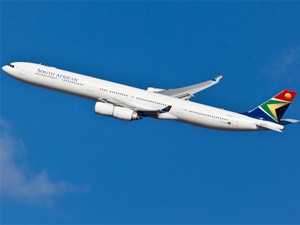
The South African Airways (SAA) has deployed the Required Navigation Performance-Authorisation Required (RNP-AR) technology for its flights.
RNP is performance-based navigation technology that allows an aircraft to fly a specific path between two 3D-defined points, enabling planes to follow precise 3D curved flight paths through congested airspaces, around noise-sensitive areas, or through difficult terrain. Unlike traditional instrument approaches, RNP-AR is not bound by restrictive "straight line" design criteria, SAA says.
Speaking to the media this morning, captain Sandy Bayne, head of flight operations at SAA, said SAA can save up to $635 000 (R7.1 million) in a year with the use of RNP technology. "Using upgraded navigation systems, RNP-AR-equipped aircraft are able to fly a more efficient path as they approach an airport and prepare for landing," he said. RNP-AR works independently of ground-based radio stations, unlike traditional means.
Development of the software took SAA about 18 months and it has been trialling the technology for the past three years.
Bayne noted the whole project cost the state-owned carrier R25 million and SAA is set to use Cape Town International Airport for the pilot programme. Cape Town has been selected because there are 19 SAA flights per day to that destination, he said.
He added much of the money was used in the development of the software as well as training pilots and air traffic controllers.
Fuel savings
Also speaking during the event, Andrew Smith, senior first officer at SAA, said the benefits of RNP include reducing track miles for aircraft, saving fuel, carbon emission reduction as well as trimming the noise that aircraft make.
Smith said this technology represents the future of aviation, adding that every flight can cut flying time by two minutes in the process of approaching, landing and taxying at Cape Town.
"This might look like a small number but if you consider the number of flights that we make in a year, it makes a lot of sense in regards to saving fuel as well as reducing carbon emissions and noise," Smith said. "The shorter the time we keep our engines running, the longer they will also be functional.
"Instead of a pilot sorely relying on air traffic controllers to approach and land, the technology gives the pilot a clear path without them doing much."
Smith adds: "Using upgraded navigation systems, RNP-AR-equipped aircraft are able to fly a more efficient path as they approach an airport and prepare for landing." Research conducted by French company, Airbus Prosky, showed potential savings of over 690 tonnes of fuel and a reduction of some 230 hours of flight time per year, based on an average saving of 100kg of fuel per approach," he added.
SAA will also be making the technology available to other airlines for free, said Smith, and the company is set to assist Malawi's Blantyre Airport - known for its unfriendly landing environment - with the technology, Bayne said. He added the technology has already seen interest from companies like Qatar Airlines.
Specs
In technical terms, RNP-AR allows the aircraft to fly in curved Standard Instrument Departure (SID), Standard Instrument Arrival (STAR) and Instrument Approach Procedures (IAP) to a lateral accuracy level of between 0.1nm and 0.3nm, said Smith. SID is a navigation procedure which guides aircraft after take-off, while STAR is a navigation procedure which guides the aircraft towards the airport before it begins the approach.
Airbus Prosky handled the project design and management, with the scope broadened to include the design of RNP-AR SID, STAR and IAP for routes into Cape Town from Johannesburg, Durban and London; and the delivery of Operational Approval Packages and Flight Operational Safety Assessments, which is the quality assurance process that ensures safety is not comprised.
Simultaneously, SAA Technical upgraded its Airbus A319 and six Boeing 737-800 aircraft to RNP-AR 0.3 specification. The recently supplied Airbus A330-200 and A320 fleet arrived factory-equipped with this technology. The project was collaboratively executed among parties which included Air Traffic and Navigation Services and the South African Civil Aviation Authority. "Without the participation of these two parties, this project would have not been possible," said Bayne.
In 1996, Alaska Airlines became the first airline in the world to use an RNP approach with its approach down the Gastineau Channel into Juneau, Alaska.
Share